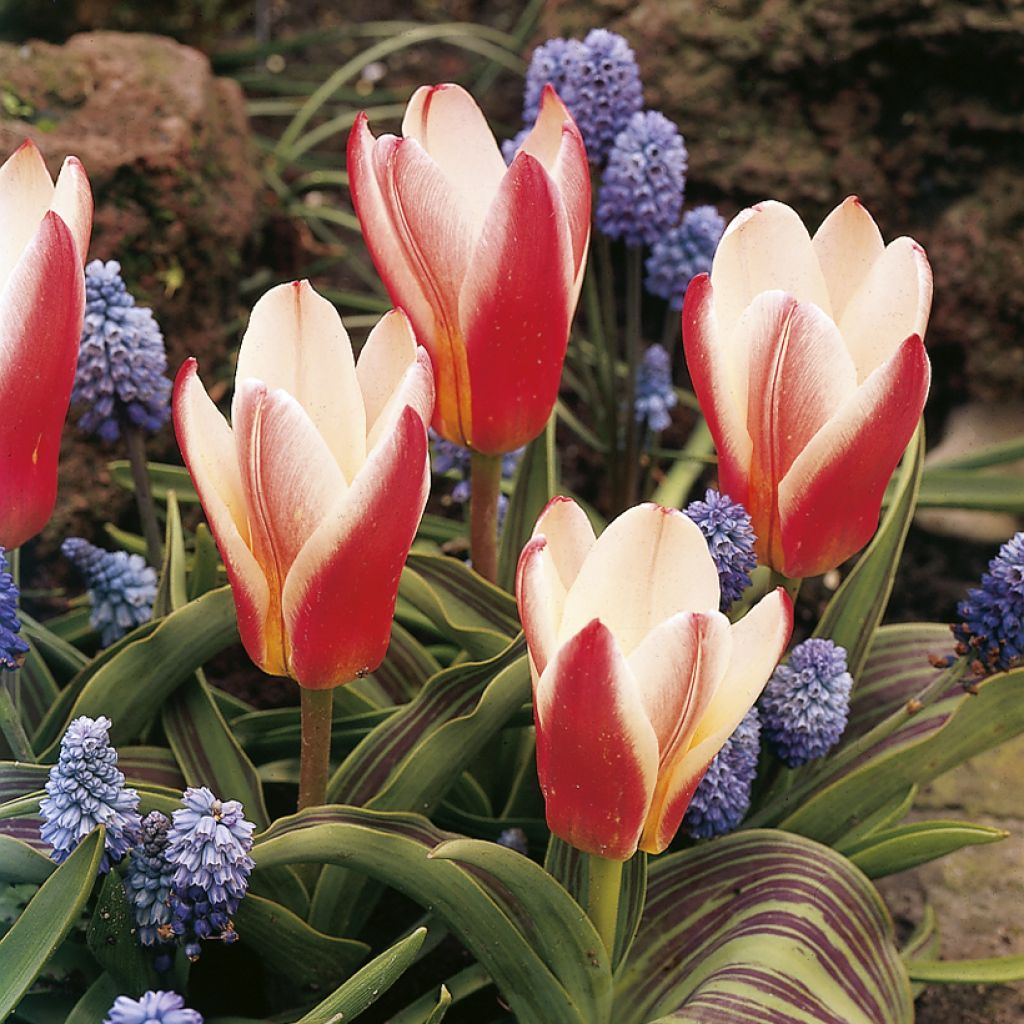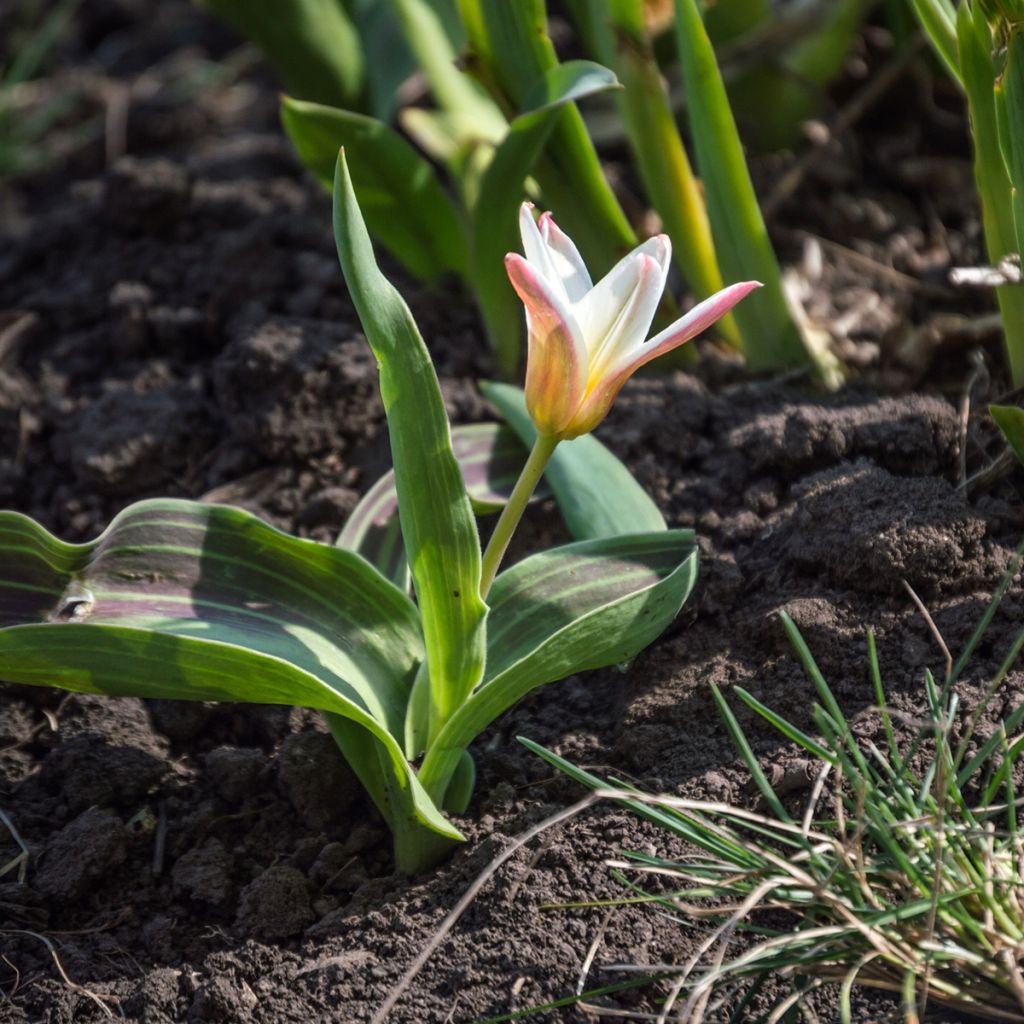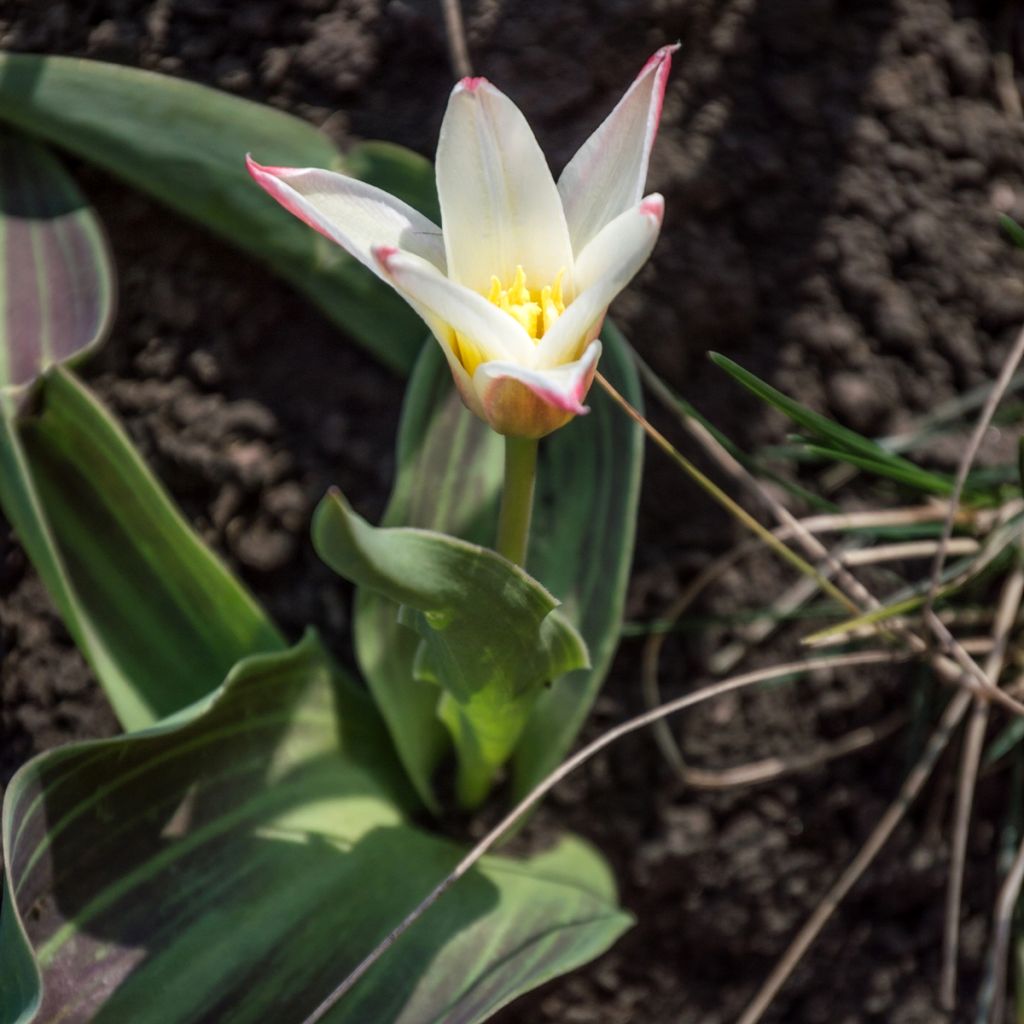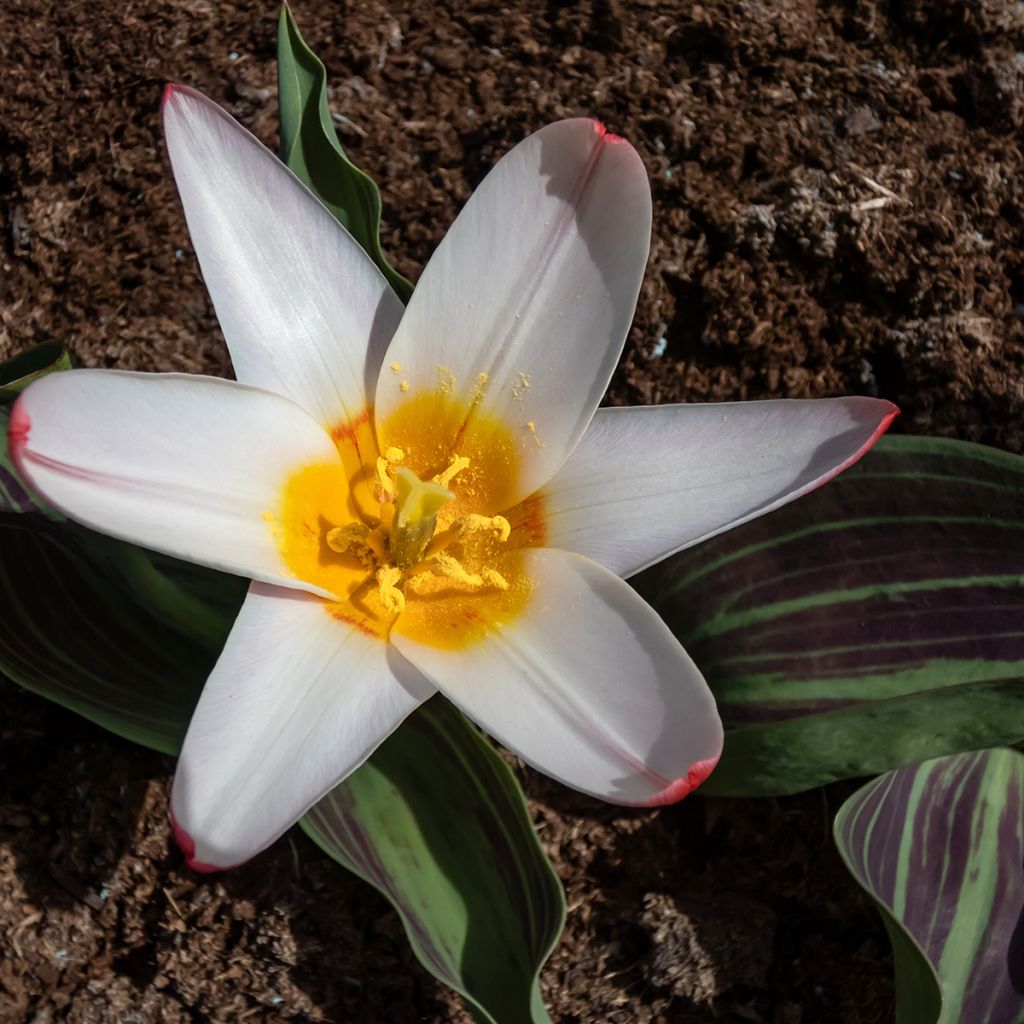

Tulipa kaufmanniana Hearts Delight


Tulipa kaufmanniana Hearts Delight


Tulipa kaufmanniana Hearts Delight


Tulipa kaufmanniana Hearts Delight
Tulipa kaufmanniana Hearts Delight
Tulipa kaufmanniana Heart's Delight
Waterlily tulip
This plant carries a 6 months recovery warranty
More information
We guarantee the quality of our plants for a full growing cycle, and will replace at our expense any plant that fails to recover under normal climatic and planting conditions.
From €5.90 for pickup delivery and €6.90 for home delivery
Express home delivery from €8.90.
Does this plant fit my garden?
Set up your Plantfit profile →
Description
The Tulipa kaufmanniana 'Heart's Delight' is a variety of small size, with very early flowering, which belongs to the "water lily" tulips, whose corolla unfolds like a water lily. It is similar to a delightful botanical species that blooms from the end of winter. This variety, Heart's Delight, produces carmine flowers edged with pale pink to white, enhanced with yellow at the base. Under the flower, there is more or less marbled purple foliage that is not without charm. This hardy bulbous plant naturalises quite easily in well-drained soils, even dry in summer. Combine it with randomly scattered botanical crocuses in your shrub and perennial beds.
Native to the mountains of Central Asia, the Tulipa kaufmanniana or Kaufmann's Tulip extends in large carpets on the dry and rocky meadows of its native Turkestan. This species is the origin of numerous cultivars and hybrids with bright colours, including the pretty variety 'Heart's Delight', introduced to the market in 1952. Its bulb is round, covered with a brown tunic, and measures about 3 cm (1in) in diameter. The plant forms a small clump in spring composed of 2 to 5 lanceolate, wide leaves, 10 to 25 cm (4 to 10in) long. The flowering stem, 15 to 20 cm (6 to 8in) tall, sometimes bears the bud of a pink-red, which will release a flower in March with 6 petals that are not pointed, but have rounded edges. It opens widely in the sun, almost flat, in a hexagonal star shape, 5 to 8 cm (2 to 3in) in diameter. The inside of the corolla is almost white, revealing a yellow heart. At this moment, it resembles more a water lily than a tulip. The corolla closes when the sun hides. 'Heart's Delight' exhibits more colourful petals on the outside. They are coloured with bright pink-red towards the centre, lighter on the edges. The base of the petals is yellow.
The Kaufmann's tulips are very hardy plants that naturalise easily in the garden under the right conditions. They prefer cold and humid winters and dry summers. They are used in sunny rockeries or at the base of deciduous trees and shrubs with late foliage, such as deciduous spindles, or with light foliage like certain elderberries. 'Heart's Delight', with its delightful flowering, pairs very well with crocuses and early white botanical daffodils, which bloom at around the same time, in March-April. You can also plant their bulbs in pots on your terrace or balcony, their flowering will celebrate the arrival of spring.
Report an error about the product description
Tulipa kaufmanniana Hearts Delight in pictures




Plant habit
Flowering
Foliage
Botanical data
Tulipa
kaufmanniana
Heart's Delight
Liliaceae
Waterlily tulip
Cultivar or hybrid
Planting and care
Plant your Kaufmann tulips as soon as possible in a well-drained soil. Loosen the soil deeply, incorporate coarse sand or gravel into the planting soil if necessary. Plant at a depth of 8 cm (3in) (Bulbs should be covered with twice their height of soil). Space the bulbs a few centimeters apart, making sure they do not touch each other. Choose a sunny location, at least until May, for better flowering. Kaufmann tulips go dormant in the summer in dry soil, even shaded by deciduous trees or bushes. After flowering, cut the flower stalks and let the leaves dry completely before cutting them.
Advice for flowered carpets: You can create beautiful flowered spaces around the house, in flowerbeds, around trees, or in wild areas. It is an economical and sustainable solution, provided that a few principles are respected:
1) This is a planting to leave in place.
2) Choose the varieties carefully according to the situation.
3) A period of rest is essential after flowering for the bulbs to regenerate. Let the foliage turn yellow and dry before cutting it.
4) Organic fertilizer should be spread once a year in autumn.
Planting period
Intended location
Care
This item has not been reviewed yet - be the first to leave a review about it.
Haven't found what you were looking for?
Hardiness is the lowest winter temperature a plant can endure without suffering serious damage or even dying. However, hardiness is affected by location (a sheltered area, such as a patio), protection (winter cover) and soil type (hardiness is improved by well-drained soil).

Photo Sharing Terms & Conditions
In order to encourage gardeners to interact and share their experiences, Promesse de fleurs offers various media enabling content to be uploaded onto its Site - in particular via the ‘Photo sharing’ module.
The User agrees to refrain from:
- Posting any content that is illegal, prejudicial, insulting, racist, inciteful to hatred, revisionist, contrary to public decency, that infringes on privacy or on the privacy rights of third parties, in particular the publicity rights of persons and goods, intellectual property rights, or the right to privacy.
- Submitting content on behalf of a third party;
- Impersonate the identity of a third party and/or publish any personal information about a third party;
In general, the User undertakes to refrain from any unethical behaviour.
All Content (in particular text, comments, files, images, photos, videos, creative works, etc.), which may be subject to property or intellectual property rights, image or other private rights, shall remain the property of the User, subject to the limited rights granted by the terms of the licence granted by Promesse de fleurs as stated below. Users are at liberty to publish or not to publish such Content on the Site, notably via the ‘Photo Sharing’ facility, and accept that this Content shall be made public and freely accessible, notably on the Internet.
Users further acknowledge, undertake to have ,and guarantee that they hold all necessary rights and permissions to publish such material on the Site, in particular with regard to the legislation in force pertaining to any privacy, property, intellectual property, image, or contractual rights, or rights of any other nature. By publishing such Content on the Site, Users acknowledge accepting full liability as publishers of the Content within the meaning of the law, and grant Promesse de fleurs, free of charge, an inclusive, worldwide licence for the said Content for the entire duration of its publication, including all reproduction, representation, up/downloading, displaying, performing, transmission, and storage rights.
Users also grant permission for their name to be linked to the Content and accept that this link may not always be made available.
By engaging in posting material, Users consent to their Content becoming automatically accessible on the Internet, in particular on other sites and/or blogs and/or web pages of the Promesse de fleurs site, including in particular social pages and the Promesse de fleurs catalogue.
Users may secure the removal of entrusted content free of charge by issuing a simple request via our contact form.
The flowering period indicated on our website applies to countries and regions located in USDA zone 8 (France, the United Kingdom, Ireland, the Netherlands, etc.)
It will vary according to where you live:
- In zones 9 to 10 (Italy, Spain, Greece, etc.), flowering will occur about 2 to 4 weeks earlier.
- In zones 6 to 7 (Germany, Poland, Slovenia, and lower mountainous regions), flowering will be delayed by 2 to 3 weeks.
- In zone 5 (Central Europe, Scandinavia), blooming will be delayed by 3 to 5 weeks.
In temperate climates, pruning of spring-flowering shrubs (forsythia, spireas, etc.) should be done just after flowering.
Pruning of summer-flowering shrubs (Indian Lilac, Perovskia, etc.) can be done in winter or spring.
In cold regions as well as with frost-sensitive plants, avoid pruning too early when severe frosts may still occur.
The planting period indicated on our website applies to countries and regions located in USDA zone 8 (France, United Kingdom, Ireland, Netherlands).
It will vary according to where you live:
- In Mediterranean zones (Marseille, Madrid, Milan, etc.), autumn and winter are the best planting periods.
- In continental zones (Strasbourg, Munich, Vienna, etc.), delay planting by 2 to 3 weeks in spring and bring it forward by 2 to 4 weeks in autumn.
- In mountainous regions (the Alps, Pyrenees, Carpathians, etc.), it is best to plant in late spring (May-June) or late summer (August-September).
The harvesting period indicated on our website applies to countries and regions in USDA zone 8 (France, England, Ireland, the Netherlands).
In colder areas (Scandinavia, Poland, Austria...) fruit and vegetable harvests are likely to be delayed by 3-4 weeks.
In warmer areas (Italy, Spain, Greece, etc.), harvesting will probably take place earlier, depending on weather conditions.
The sowing periods indicated on our website apply to countries and regions within USDA Zone 8 (France, UK, Ireland, Netherlands).
In colder areas (Scandinavia, Poland, Austria...), delay any outdoor sowing by 3-4 weeks, or sow under glass.
In warmer climes (Italy, Spain, Greece, etc.), bring outdoor sowing forward by a few weeks.


































